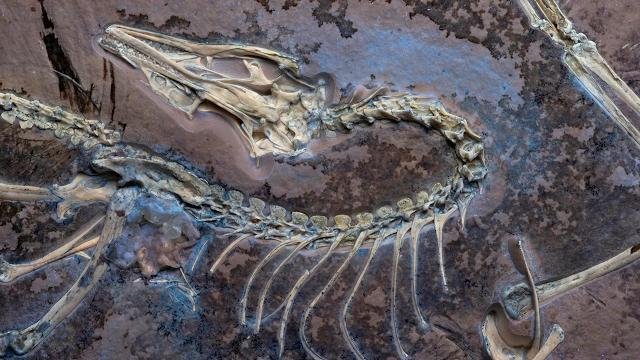
Ancient Deadly Predators: The Mosura Fentoni
Ancient Deadly Predators: The Mosura Fentoni
Written by: Keya Gambhir
A long, long time ago, about 506 million years ago, there was a tiny sea creature called Mosura fentoni. It lived in the ancient oceans of what is now Canada. Scientists at the Manitoba Museum and the Royal Ontario Museum recently discovered fossils of this fascinating predator in a special place called the Burgess Shale. This site is famous for holding lots of well-preserved fossils from the Cambrian period, a time when many animals first appeared on Earth.
What Did Mosura Look Like?
Mosura was about the size of your index finger. It had three eyes on its head, spiny claws that looked like something out of a fantasy story, and a round mouth lined with tiny teeth perfect for catching prey. Along the sides of its body were swimming flaps that helped it glide through the water. Because of its shape and swimming style, scientists nicknamed it the "sea moth."
Even though it is called a sea moth, Mosura was not related to real moths. Instead, it belonged to a group called radiodonts, ancient relatives of today’s spiders, crabs, and insects, all part of the large arthropod family. One of the most famous radiodonts was Anomalocaris, a much bigger predator about a meter long, that lived in the same ancient seas.
What Makes Mosura So Special?
What sets Mosura apart from other radiodonts is its complex body. Instead of having a simple tail, Mosura’s rear end had 16 tiny segments lined with gills, similar to the breathing parts found in modern arthropods. These gills helped Mosura breathe underwater and may have allowed it to live in different places or swim in unique ways.
Scientists also found fossils showing parts of Mosura’s inside body. This includes its nervous system, which helped it sense its surroundings, its digestive system for eating food, and its circulatory system, which is how blood flows through the body.
Unlike humans, Mosura had an open circulatory system. This means its heart pumped blood not through vessels but into large body spaces called lacunae, which then carried the blood to its swimming flaps and other parts of the body.
How Did Mosura Move?
Mosura likely swam by moving its body flaps in a way similar to how modern stingrays glide through water. This efficient swimming method helped it hunt for prey in the ancient seas. With its three eyes and sharp claws, it was a skilled predator in its environment, sharing the ocean with other early sea creatures, including the much larger Anomalocaris canadensis.
Why Is This Discovery Important?
The discovery of Mosura offers exciting new clues about how early animals lived and evolved. The Cambrian period is famous for the "Cambrian Explosion," when many complex animals suddenly appeared on Earth. But scientists have been curious about how quickly animals developed their different body parts during that time.
Mosura shows that radiodonts, once thought to be simple creatures, were quite complex and evolving rapidly. The multi-segmented body and specialized gills suggest these animals were experimenting with different body designs, which later helped arthropods become one of the most successful groups of animals alive today.
Stewart Edie, a paleobiologist at the Smithsonian Museum of Natural History, says this discovery helps scientists understand that life was diverse and evolving quickly even before the Cambrian Explosion’s big burst of new animals.
Where Were Mosura Fossils Found?
Most Mosura fossils were discovered in the Canadian Rockies, specifically in Yoho National Park and Kootenay National Park in British Columbia. These parks protect the Burgess Shale, a treasure trove of ancient fossils. Interestingly, some fossils of Mosura were collected almost 100 years ago by Charles Walcott, the scientist who first discovered the Burgess Shale fossils back in the early twentieth century.
See Mosura in Museums!
If you want to see fossils like Mosura, you can visit the Royal Ontario Museum in Toronto. They have a special gallery called the Willner Madge Gallery, Dawn of Life, where many Burgess Shale fossils are on display. Later this year, a Mosura fossil will also be exhibited at the Manitoba Museum in Winnipeg.
Isn’t it amazing to imagine a tiny, three-eyed creature like Mosura swimming through the ancient seas more than half a billion years ago? Thanks to fossils and careful study, scientists help us travel back in time to discover the mysteries of early life on Earth.
If you want to learn more about cool discoveries like Mosura, keep exploring, stay curious, and keep asking questions. Who knows what you might discover next?
References
“A New Species of Ancient Cambrian Predator Named After Mothra.” Natural History Museum, May 2025. https://www.nhm.ac.uk/discover/news/2025/may/new-species-ancient-cambrian-predator-named-after-mothra.html.
“Mosura Fentoni.” Sci.News. https://www.sci.news/paleontology/mosura-fentoni-13906.html.
“Sea Creature Fossil of Three-Eyed Predator ‘Mosura’.” NPR, May 17, 2025. https://www.npr.org/2025/05/17/g-s1-67434/sea-creature-fossil-three-eyed-predator-mosura.


